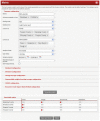ISS--an electronic syndromic surveillance system for infectious disease in rural China
- PMID: 23626853
- PMCID: PMC3633833
- DOI: 10.1371/journal.pone.0062749
ISS--an electronic syndromic surveillance system for infectious disease in rural China
Abstract
Background: Syndromic surveillance system has great advantages in promoting the early detection of epidemics and reducing the necessities of disease confirmation, and it is especially effective for surveillance in resource poor settings. However, most current syndromic surveillance systems are established in developed countries, and there are very few reports on the development of an electronic syndromic surveillance system in resource-constrained settings.
Objective: This study describes the design and pilot implementation of an electronic surveillance system (ISS) for the early detection of infectious disease epidemics in rural China, complementing the conventional case report surveillance system.
Methods: ISS was developed based on an existing platform 'Crisis Information Sharing Platform' (CRISP), combining with modern communication and GIS technology. ISS has four interconnected functions: 1) work group and communication group; 2) data source and collection; 3) data visualization; and 4) outbreak detection and alerting.
Results: As of Jan. 31(st) 2012, ISS has been installed and pilot tested for six months in four counties in rural China. 95 health facilities, 14 pharmacies and 24 primary schools participated in the pilot study, entering respectively 74,256, 79,701, and 2330 daily records into the central database. More than 90% of surveillance units at the study sites are able to send daily information into the system. In the paper, we also presented the pilot data from health facilities in the two counties, which showed the ISS system had the potential to identify the change of disease patterns at the community level.
Conclusions: The ISS platform may facilitate the early detection of infectious disease epidemic as it provides near real-time syndromic data collection, interactive visualization, and automated aberration detection. However, several constraints and challenges were encountered during the pilot implementation of ISS in rural China.
Conflict of interest statement
Figures








Similar articles
-
Establishing a web-based integrated surveillance system for early detection of infectious disease epidemic in rural China: a field experimental study.BMC Med Inform Decis Mak. 2012 Feb 3;12:4. doi: 10.1186/1472-6947-12-4. BMC Med Inform Decis Mak. 2012. PMID: 22305256 Free PMC article.
-
A cost-effectiveness analysis of three components of a syndromic surveillance system for the early warning of epidemics in rural China.BMC Public Health. 2015 Nov 14;15:1127. doi: 10.1186/s12889-015-2475-x. BMC Public Health. 2015. PMID: 26577518 Free PMC article.
-
Collecting syndromic surveillance data by mobile phone in rural India: implementation and feasibility.Glob Health Action. 2015 Apr 2;8:26608. doi: 10.3402/gha.v8.26608. eCollection 2015. Glob Health Action. 2015. PMID: 25843499 Free PMC article.
-
Effectiveness of Public Health Digital Surveillance Systems for Infectious Disease Prevention and Control at Mass Gatherings: Systematic Review.J Med Internet Res. 2023 May 19;25:e44649. doi: 10.2196/44649. J Med Internet Res. 2023. PMID: 37204833 Free PMC article.
-
Virtual surveillance of communicable diseases: a 20-year experience in France.Stat Methods Med Res. 2006 Oct;15(5):413-21. doi: 10.1177/0962280206071639. Stat Methods Med Res. 2006. PMID: 17089946 Review.
Cited by
-
Utilisation of Electronic Health Records for Public Health in Asia: A Review of Success Factors and Potential Challenges.Biomed Res Int. 2019 Jul 8;2019:7341841. doi: 10.1155/2019/7341841. eCollection 2019. Biomed Res Int. 2019. PMID: 31360723 Free PMC article.
-
Measuring costs of data collection at village clinics by village doctors for a syndromic surveillance system-a cross sectional survey from China.BMC Health Serv Res. 2015 Jul 25;15:287. doi: 10.1186/s12913-015-0965-2. BMC Health Serv Res. 2015. PMID: 26208506 Free PMC article.
-
Integrating malaria surveillance with climate data for outbreak detection and forecasting: the EPIDEMIA system.Malar J. 2017 Feb 23;16(1):89. doi: 10.1186/s12936-017-1735-x. Malar J. 2017. PMID: 28231803 Free PMC article.
-
Applying the zero-inflated Poisson model with random effects to detect abnormal rises in school absenteeism indicating infectious diseases outbreak.Epidemiol Infect. 2018 Sep;146(12):1565-1571. doi: 10.1017/S095026881800136X. Epub 2018 May 30. Epidemiol Infect. 2018. PMID: 29843830 Free PMC article.
-
Assessing Commitment and Reporting Fidelity to a Text Message-Based Participatory Surveillance in Rural Western Uganda.PLoS One. 2016 Jun 9;11(6):e0155971. doi: 10.1371/journal.pone.0155971. eCollection 2016. PLoS One. 2016. PMID: 27281020 Free PMC article.
References
-
- Henning KJ (2004) What is syndromic surveillance? MMWR 53 Suppl: 5–11 - PubMed
Publication types
MeSH terms
LinkOut - more resources
Full Text Sources
Other Literature Sources
Medical
Research Materials

